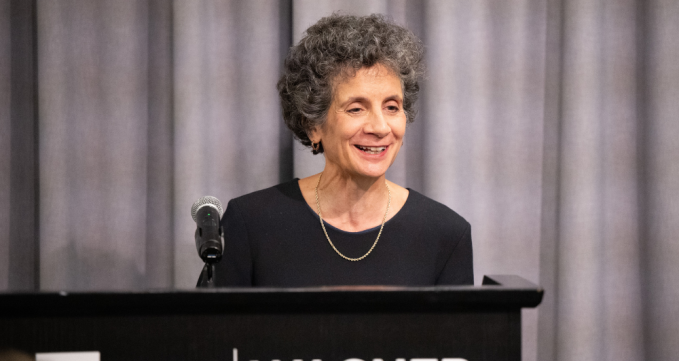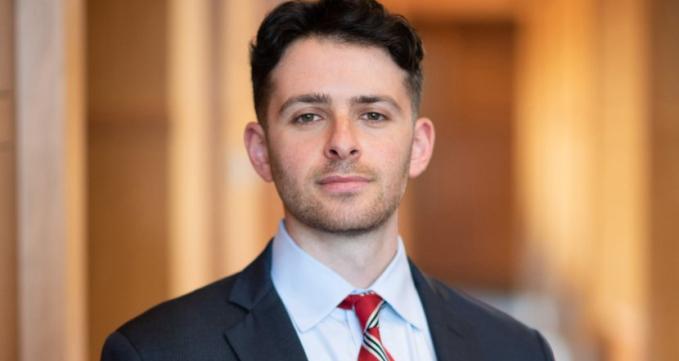Reflections from the 2023 Henry Hart Rice Urban Policy Forum: A Dynamic Policy Dialogue
On October 18, 2023, NYU Wagner hosted its annual Henry Hart Rice Urban Policy Forum, a hallmark event that brought t
An Evening with NYC Government: Wagner Alumni working in NYC Government Share Career Insights with Current Students

On October 12th, 2023, the NYU Wagner Office of Career Services (OCS), in partnership with the NYU Wagner O
BIKE THEFT MITIGATION FOR NYC DELIVERY WORKERS
The Capstone team identified a problem within the NYC delivery worker community: current motion sensor on-bike alarms fail to notify workers of security breaches to bikes locked on the street while workers are making in-building deliveries (which typically last one to ten minutes). It is estimated that fifty percent of delivery workers in NYC fall victim to e-bike theft, yet delivery work is subject to minimal regulation and workers have almost no workplace protections. The Capstone team created a solution called Tandem, with the goal of providing delivery workers protection from theft. Tandem’s 4G LTE-enabled motion-sensor alarm helps NYC food delivery workers avoid the cost of e-bike replacement by: 1) providing motion-sensor phone alerts so that workers have a sufficient window of time to return to their bikes during theft attempts, and 2) streamlining communications within the delivery worker community through GPS sharing of bike locations to social networks in case of attempted thefts.
GREENWAY CONNECTIVITY PLAN
The Jersey City Department of Infrastructure, Division of Transportation Planning (DTP) oversees the planning and development of a well-functioning and safe transportation system. Jersey City’s 2019 Let’s Ride JC Bicycle Master Plan called for more than 20 miles of shared-use bike and pedestrian paths (“greenways”) but did not consider how those greenways would connect to each other and to Jersey City sidewalks, bike lanes, and parks. To close the gap, DTP engaged the Capstone team to evaluate and recommend potential greenway connections. The team gained a thorough understanding of the context of Jersey City’s planned and existing greenways through a scan of existing conditions and prior greenway plans, and through public engagement that included key stakeholder interviews, a community survey, and two public workshops. The team also gleaned greenway planning best practices through a comprehensive literature review and greenway case study analysis. These research efforts allowed the team to create a scoring tool to evaluate proposed connections and recommend priority projects, informing the Jersey City Greenway Connectivity Plan.
PROMOTING ACCESS AND CONNECTIVITY ALONG THE FAR WEST SIDE
Manhattan Community Board 4 (MCB4) commissioned a Capstone Team to explore strategies for improving connectivity and accessibility to the Far West Side (defined as 14th Street to 59th Street, West of 11th Avenue, Manhattan). The team joined MCB4 stakeholders on four site visits comprising the study area, led five focus groups composed of residents, real estate professionals, and government and community-based organization (CBO) leaders, and conducted landscape analyses using publicly available qualitative and quantitative data. The team identified three key focus areas on the Far West Side with either a unique challenge or unrealized potential to better promote access and connection. In addition, the team provided study area-wide recommendations to help MCB4 shape its future policy agenda and guide subsequent planning initiatives to increase inclusivity, safety, and accessibility along the Far West Side.
OPPORTUNITY ZONES AND CRIME IN NYC
The Capstone Team used geographic regression discontinuity to understand the causal relationship between Opportunity Zone (OZ) designation and crime in New York City. The Team restricted its study to the effect of OZ designation on arrests and complaints for property and violent crime. In its final report, the Team reported its initial findings that suggest OZ designation has a limited effect on property and violent crime. In every quarter for two years after the policy change, a small and statistically insignificant difference occurs in property and violent crime arrests and complaints between census blocks in OZs and adjacent census blocks just outside OZs. However, when adjusted for seasonality, including fixed effects for the quarter when the crime incident occurred, the team observed a statistically significant pattern of increasing violent crime arrests and decreasing violent crime complaints inside OZs. However, the effect of OZ designation on violent crime complaints loses statistical significance in the second year and using the polynomial model. There is no such observable pattern for property crime arrests or complaints.
CREATING AN ACTIONABLE PLAN TO LOWER MUNICIPAL EMISSIONS
The Village of Ardsley is a small municipality in Westchester County serving a population of just over 5,000 people. The Village seeks to reduce its environmental impact by lowering the emissions produced by its municipal transportation fleet without negatively impacting its services. The Village's goal is to reduce vehicle emissions from its municipal fleet through policy changes that lower its reliance on fossil fuels. To understand the problem and identify feasible solutions, the team a) conducted a literature review, industry research, and interviews with village representatives, b) surveyed comparable municipalities on the benefits and challenges of electric vehicle adoption, and c) prepared a vehicle inventory report. The team provided the Village with a final report containing recommendations for decreasing its municipality’s vehicle emissions—ensuring its current fleet is performing efficiently, establishing infrastructure that supports emerging vehicle technologies, implementing a plan for future vehicle purchases, and providing recommendations for alternative policies that can reduce emissions.
ANTI-DISPLACEMENT AND COMMUNITY OWNERSHIP STRATEGIES FOR EAST FLATBUSH
Brooklyn Community Board 17 (CB17) is working with Brooklyn Level Up (BKLVLUP), a community development corporation and community land trust, to preserve homeownership and prevent displacement in East Flatbush. The client engaged the Capstone team to analyze existing conditions in the neighborhood, including demographics, land use and zoning, existing housing stock, and recent development. The team also researched potential engagement strategies and reviewed case studies of strategies used to prevent displacement and maintain housing affordability in neighborhoods facing similar issues. Based on its findings, the team provided recommendations, including both zoning and non-zoning strategies, to improve access to stable homeownership and affordable rental housing, as well as specific engagement strategies for CB17 and BKLVLUP to utilize as they continue working toward a neighborhood rezoning and a more stable, equitable East Flatbush.


